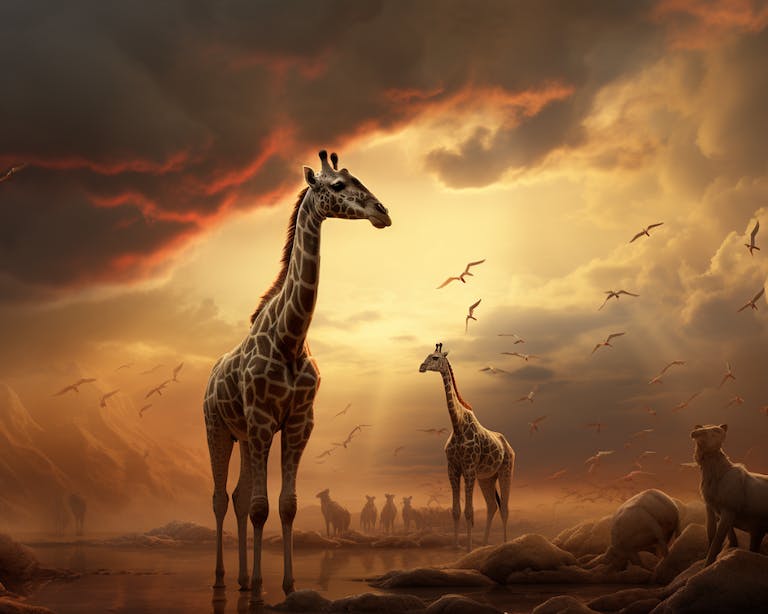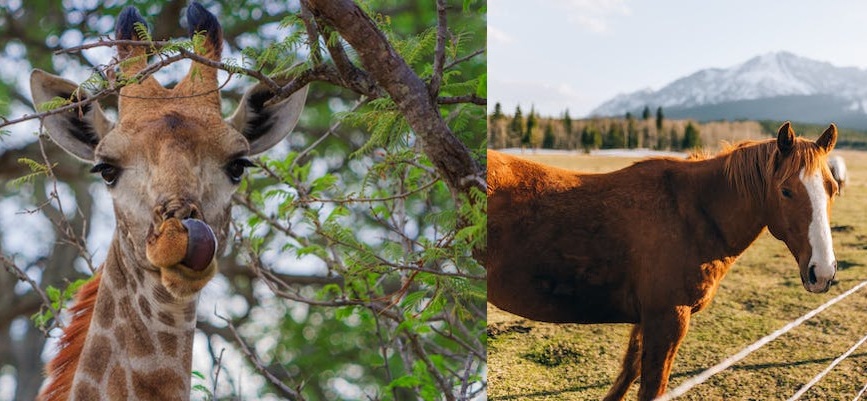Are giraffes related to horses? No, they do not relate. Giraffes and horses are two of the world’s most iconic and recognizable animals. At first glance, they appear to have little in common. Horses are sturdy, compact animals that live in herds across grasslands and plains. Giraffes are gangly and towering, standing up to 18 feet tall with extremely long necks. Horses came from North America and went to the Old World. Giraffes developed in Africa.
Giraffes and horses have surprising connections, despite their differences. By studying their evolution, physiology, genetics, and behaviour, we find interesting similarities. Understanding these links helps reveal how changes can unexpectedly affect animals and create unexpected relationships between species across continents and eras. Horses are part of Perissodactyla, also known as odd-toed ungulates, including rhinos and tapirs.
Table of Contents
Are giraffes related to horses? A Scientific Perspective
In a scientific perspective, giraffes are not closely related to horses. Although they both belong to the order of mammals and are herbivores, their genetic lineage and physical traits show that they are not directly related. Horses belong to the family Equivale and are characterized by their single hoof on each foot, while giraffes belong to the family Giraffid and are known for their long neck and legs.
The genetic studies have revealed that giraffes are more closely related to other ruminants, such as deer and cattle, than horses. Despite their similar roles as herbivorous animals with long limbs, their genetic and anatomical differences point to the fact that their evolutionary paths diverged long ago, leading to the distinct and fascinating creatures that we know today. Therefore, while giraffes and horses may share some common traits as herbivores with long legs, they are not closely related in the scientific sense.
You may like: Can horses eat broccoli? Potential benefits and risks
Shared Evolutionary History of Horses and Giraffes

Though they seem quite different, giraffes and horses share some surprising common ancestry. Both of these large mammal species evolved from small, forest-dwelling animals over 50 million years ago. Horses and giraffes belong to the biological order Perissodactyl, which includes odd-toed ungulates. This means that members of this group walk on their toes rather than flat on their feet.
The ancient ancestors of modern horses and giraffes first appeared in North America before spreading to other continents as the land masses drifted apart. Over millions of years, horses and giraffes evolved in separate directions but retained some similar characteristics due to their distant shared origins.
This ancient connection can be seen in certain parallels between horse and giraffe anatomy and behaviour today. Comprehending this tale is key to addressing our query: Are giraffes related to horses?
Ancient Horses
Horses have a long history that goes back 50 million years. The earliest known relative of the modern horse is called Hyracotherium, or the dawn horse. It lived around 50 million years ago and was a small forest-dwelling animal about the size of a fox. It had four toes on its front feet and three toes on its hind feet.
Over millions of years, horses evolved from these small ancestors to become larger and adapt to open grasslands instead of forests. As grasslands expanded, early horse species evolved longer legs and taller statures to see over grass and run quickly in open areas. Horses belong to the genus Equus and the family Equidae. Horses are born under the Equus class in the Equidae family.
Their diets also shifted from eating leaves to grazing on grass. One important change was the reduction in the number of toes as horses adapted for running, going from four toes to three, and then to just one main hoof on each foot. Around 10 million years ago, horse ancestors, like Mesohippus, became smaller and started living in grasslands instead of forests.
Over the next 10 million years, horses evolved into bigger, faster grazers suited for life on open plains. They developed their modern form about 4 million years ago. This means that horses changed from small forest eaters to the big, fast grazers we see today.
Ancient Giraffes
Giraffes have an evolutionary history stretching back over 25 million years. One of the earliest known primitive ancestors of the modern giraffe was called Canthumeryx. This ancient giraffe relative lived around 25 million years ago in Africa. At the time, giraffes were not very tall and looked more like large deer.
Over millions of years, giraffes evolved to grow taller and develop long necks. This allowed them to reach leaves high up in the tops of African trees. Giraffes also evolved specially adapted long tongues to grasp leaves while browsing in trees.
Unlike horses, giraffes belong to the mammal order Artiodactyla. This is the order of even-toed hoofed mammals like cows, pigs, and deer. Within this order, giraffes make up the Giraffidae family of long-necked African mammals. The only other living member of the Giraffidae family is the okapi.
Though not closely related, giraffes do have some animal kingdom relatives, like donkeys and zebras, that also have hooves with an odd number of toes. In the case of giraffes, they evolved to have two toes on each foot with cloven hoofs.
Over millions of years, giraffes have specially adapted to their browsing lifestyle, reaching up high into tree canopies in the African savannas and woodlands. Their incredible height and long tongues are key evolutionary developments. Giraffes are not a type of horse, as they come from a different breed of animal.
You may like: 12 Common Horse Health Issues and Remedies: a Complete guide
Comparing Giraffes and Horses: Similarities and Differences
Giraffes and horses are not closely related to each other. but they still have some similarities. While both giraffes and horses are mammals, they belong to different orders. In addition to the misconception that giraffes are related to horses,.
Comparing Physical Features: Horses and Giraffes
Though they evolved separately, horses and giraffes developed some surprisingly similar physical adaptations.
Both horses and giraffes have very long, muscular hind legs. This allows them to deliver powerful kicks and run at fast speeds. Their front legs also evolved for speed and weight support while eating. Since horses graze on grass with their heads down, their front legs are built to bear weight for long periods of time. Giraffes’ front legs have more flexibility to maneuver while browsing high branches. The hooves of large male giraffes reach 31 cm × 23 cm (12.2 in × 9.1 in) in diameter.
The necks of both horses and giraffes became elongated over time as adaptations for their feeding strategies. Horses have longer necks to allow them to graze grass low to the ground across a wide area without expending extra energy moving. Giraffes’ extremely long necks enable them to reach high tree leaves that other animals cannot access.
Additionally, horses and giraffes both developed relatively lightweight, slender bones compared to other large mammals. Their bones are also thick and dense, which gives them both the staying power to run over long distances without tiring.
So while adapted for different diets, both grazers and browsers evolved similar physical traits for speed and endurance. Their long legs, elongated necks, and light yet strong bones allow horses and giraffes to thrive in the diverse environments they occupy.
Cardiovascular Systems
To effectively circulate blood through their elongated bodies, horses and giraffes evolved unique cardiovascular adaptations.
Both animals developed enlarged hearts to pump blood from the heart all the way down their long necks and legs. Their immense hearts can weigh up to 9 pounds and pump large volumes of blood.
Horses and giraffes also have large lungs and specially adapted arteries. Their lungs allow them to take in more oxygen to fuel endurance running or migration. Wide carotid arteries carry oxygenated blood to the brain even at the end of their long necks.
Additionally, horses and giraffes maintain relatively moderate blood pressure compared to many other mammals. This prevents excess strain on blood vessels from their upright head-raised postures. When stressed, giraffes may chew on large branches, stripping them of bark.
These cardiovascular adaptations allow efficient circulation and oxygen delivery to support the running lifestyles and huge bodies of horses and giraffes. Their specialized hearts, lungs, and blood vessels are essential for their survival given the distances blood must travel in their elongated forms.
Gaits of Horses and Giraffes
Both horses and giraffes developed specialized fast running gaits. Galloping at high speeds and pacing with legs on one side moving together are seen in both species. Giraffes have some unique gaits like ambling with legs on each side moving separately. Horses are known for trotting diagonally and cantering with a three-beat rhythm.
Despite their size, horses and giraffes can reach fast bursts of speed over short distances thanks to their specialized leg movement patterns. So while their exact gaits differ, the ability to run swiftly for a quick getaway is a shared trait between these two long-legged mammals.
Ossicones vs. Horns
Giraffes and horses evolved unique bony protrusions on their heads called ossicones and horns, respectively.
Giraffes have up to five ossicones that are covered in skin and fur. Ossicones are formed from ossified cartilage and fuse to the giraffe’s skull as it matures. Both male and female giraffes have ossicones, which they use for defence, fighting, and cooling their blood.
Some horses develop horns made not of bone but solid keratin, the same material found in human fingernails. Most modern horses do not have horns, but certain primitive breeds still exhibit them. Like the giraffe’s ossicones, horse horns served functions like cooling, defence, establishing dominance, and attracting mates.
While their composition differs, the presence of these distinctive head protuberances in both giraffes and horses speaks to their ancient shared ancestry. These unique structures evolved to aid survival in the diverse environments ancestral giraffes and horses once shared.
Camouflage Coat Patterns
Giraffes and horses both evolved coat patterns that helped camouflage them in their native habitats.
A giraffe’s distinctive spotted coat helps it blend into the dappled light and shadows of African savanna woodlands. The uneven pattern and coloration of their spots break up the outline of their large silhouette against trees and scrubby vegetation. This helps giraffes avoid detection by predators like lions.
Similarly, many horses exhibit a multi-colored dappled coat pattern. The light and dark patches help horses blend in with the play of sunlight and shadow in open grasslands. This disruptive coloration makes it harder for predators to spot stationary horses grazing among dappled grasses.
Understanding the Behaviour and Habitat Differences
Complex Social Structures
Giraffes and horses live in groups called herds. Their herds change over time as babies are born and get older. There are young animals, older animals, male animals, and female animals in the herds.
The herds have leaders. The lead male horse is called a stallion. The lead male giraffe is called a bull. They are the bosses of their herds. Sometimes younger males challenge them to become the new leaders.
Female giraffes and horses join together in smaller groups to have and care for babies. These nursery groups help protect the young giraffes and foals. The mothers work together and get to know each other better in the nursery herds.
So while their herd types are different, giraffes and horses organize in flexible societies. The herds change as time passes. This is good for taking care of the weak babies. The herds help the giraffes and horses survive together.
Communication Systems
Giraffes and horses use sounds and smells to talk to each other.
They make different noises. Giraffes hum, snort, hiss, and grunt. Horses neigh, snort, and whinny loudly. Their sounds warn about danger, help find each other, and show they want to mate.
The smells are also important. Giraffes and horses have special scent glands on them. When they rub on trees or rocks, they leave behind smells. Their pee and poop also give off smells. These smells mark territories and give information.
So giraffes and horses make noise and use smells to communicate. This helps them stay safe in groups. Even though their noises are different, both use sounds and scents to talk in their own way.
Conservation Concerns
Giraffes and horses both face dangers from habitat loss. Their homes and land are being destroyed. Forests and grasslands are being cut down or split into smaller pieces.
This habitat loss causes problems for giraffes and horses. Giraffes’ numbers are dropping, and they are now listed as vulnerable to extinction. Some types of wild horses are also endangered because their habitats are disappearing.
Migratory routes are important too. Giraffes and horses need safe paths to move to new areas. Protecting their migration routes is key to help both animals.
People must act to keep giraffe and horse habitats and lands connected. Saving their homes and free movement will help giraffes and horses survive. We don’t want these amazing animals to keep losing their homes and becoming extinct.
Taxonomy and Classification of Giraffes and Horses
Giraffes and horses belong to the family of mammals and are both classified as ungulates, or hoofed animals. However, they are placed in different orders within the class of mammals. Giraffes fall under the order Artiodactyla, while horses are categorized under the order Perissodactyla.
Despite these differences, both giraffes and horses possess similar physical characteristics that enable them to thrive in their respective habitats. Both animals have long legs, allowing them to run fast, and are herbivores, feeding on leaves and grass. Giraffes are known for their towering height, which enables them to reach the leaves of tall trees, while horses are renowned for their strength and speed.
Can you ride a giraffe like a horse? Interesting Facts
No, giraffes cannot be ridden like horses. Here are some interesting facts explaining why:
- Giraffes are not domesticated animals. Horses have been bred and trained by humans for thousands of years, but giraffes remain wild animals not suited for riding.
- Their body shape makes riding very difficult. Giraffes have sloped backs with high shoulder blades that are not suited for saddles. Their long legs also make mounting impossible.
- Giraffes have not evolved the spine strength to support weight on their backs. A giraffe’s spine has seven vertebrae, while horses have over 30 stronger vertebrae.
- Their temperament is not as calm or trainable as horses. Giraffes are high-strung and have powerful defensive kicks that would make riding unsafe.
- Adult giraffes can grow over 15 feet tall and weigh up to 2600 pounds. Their immense size and weight would pose extreme risks to any rider.
So, while an intriguing idea, riding giraffes is not realistic or safe. Their anatomy and nature are not conducive to being ridden like the domestic horse. Giraffes are best appreciated in the wild rather than saddled up!
Conclusion
Though they belong to different biological families today, giraffes and horses share an evolutionary history stretching back over 50 million years. They descended from common ancestors that eventually adapted in separate ways to the African savannas and grasslands.
Despite their divergence, giraffes and horses retained some striking similarities that hint at their distant shared past. Both evolved long legs, necks, and cardiovascular systems to enhance speed and endurance. Their herd social structures also show parallels. And they bear unique physical traits like ossicones and dappling that aid their survival.
While adapted for different diets and habitats, giraffes and horses showcase the wondrous creativity of evolution. Their anatomical and behavioural adaptations allow them to thrive in their ecological niches. As two of nature’s most remarkable creatures, giraffes and horses teach us about the interconnections underlying all life on Earth. They represent living relics of our planet’s biological heritage.
To preserve these majestic species for future generations, we must protect their habitats and migratory pathways. Continued conservation efforts are key to ensuring the enduring success of giraffes, horses, and the many other species that share their world.
FAQs
What animal are giraffes related to?
Giraffes are most closely related to cattle and antelopes. Genetically, giraffes are in the same biological family as okapis, which are their closest living relatives.
What animal is a horse most closely related to?
The closest living relative to horses is the rhinoceros. Horses and rhinos share a common ancestor, and both are odd-toed ungulates classified in the order Perissodactyla.
Are zebras related to horses or giraffes?
Zebras are most closely related to horses. Zebras belong to the equus genus, along with horses and donkeys. They share a more recent common ancestor with other equines.
What family are giraffes from?
Giraffes belong to the giraffidae family of ruminant African mammals, which also includes the okapi. They are in the order Artiodactyla, along with antelopes, cattle, goats, and other even-toed ungulates.
Are giraffes related to camels?
No, giraffes are not closely related to camels. Camels are classified in the order Cetartiodactyla, while giraffes belong to the separate order Artiodactyla. They do not share a recent common evolutionary ancestor.







